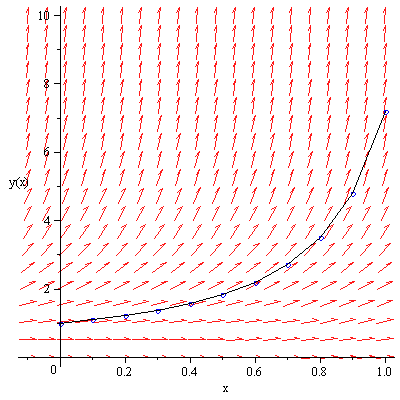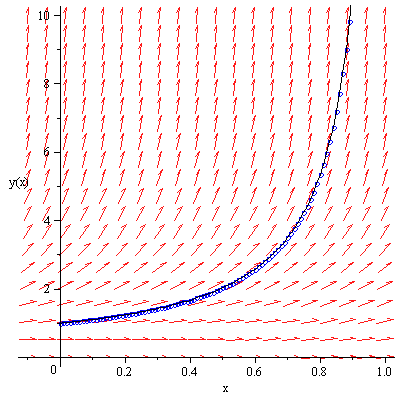MATH 132 -- Calculus for Physical and Life Science 2
An Euler's Method Example
March 12, 2008
We study the approximate solution of y' = 
with initial condition y(0) = 1. First, we load the plotting
packages. Then we do 10 steps of Euler's method with
 to approximate the solution:
to approximate the solution:
 |
 |
(1) |
| > |
for i to 10 do
xl[i]:=xl[i-1]+.1;
yl[i]:= eval(yl[i-1]+(xl[i-1]^2+yl[i-1]^2)*(.1));
end do; |
| > |
DirField:=dfieldplot(diff(y(x),x)= x^2 + y(x)^2,[y(x)],x=-.1..1,y=0..10): |
| > |
Pts:=plot([seq([xl[i],yl[i]],i=0..10)],style=point,symbol=circle,color=blue): |
| > |
Lines:=plot([seq([xl[i],yl[i]],i=0..10)],color=black): |
| > |
display(DirField,Pts,Lines); |
We would get a better approximation with smaller  . For instance, with .01:
. For instance, with .01:
| > |
for i to 100 do
xl[i]:=xl[i-1]+.01;
yl[i]:= eval(yl[i-1]+(xl[i-1]^2+yl[i-1]^2)*(.01));
end do: |
| > |
Pts:=plot([seq([xl[i],yl[i]],i=0..100)],style=point,symbol=circle,color=blue): |
| > |
Lines:=plot([seq([xl[i],yl[i]],i=0..100)],color=black): |
| > |
display(DirField,Pts,Lines); |
![]()
![]() to approximate the solution:
to approximate the solution: 
![]() . For instance, with .01:
. For instance, with .01: 